

 |
Search the Site with

|
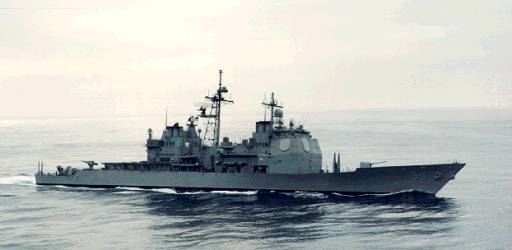 | 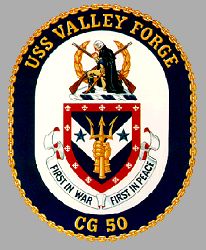 |
USS VALLEY FORGE was the fourth TICONDEROGA - class guide missile cruiser and the first ship in her class to be decommissioned. VALLEY FORGE's primary mission was to operate with aircraft carrier battle groups in extreme threat environments. The ship's purpose was to detect, classify and track hundreds of potential targets simultaneously in the air, on the surface, and under the sea. USS VALLEY FORGE was last homeported in San Diego, Calif. After decommissioning, the VALLEY FORGE was laid-up at Pearl Harbor, Hi. On November 2, 2006, she was sunk as a target off the coast of Kauai, Hawaii, becoming the first Aegis-equipped ship ever used as target in a sinkex.
| General Characteristics: | Awarded: August 28, 1981 |
| Keel laid: April 14, 1983 | |
| Launched: June 23, 1984 | |
| Commissioned: January 18, 1986 | |
| Decommissioned: August 30, 2004 | |
| Builder: Ingalls Shipbuilding, West Bank, Pascagoula, Miss. | |
| Propulsion system: four General Electric LM 2500 gas turbine engines | |
| Propellers: two | |
| Blades on each Propeller: five | |
| Length: 567 feet (173 meters) | |
| Beam: 55 feet (16,8 meters) | |
| Draft: 34 feet (10,2 meters) | |
| Displacement: approx. 9,600 tons full load | |
| Speed: 30+ knots | |
| Cost: about $1 billion | |
| Aircraft: two | |
| Armament: two | |
| Crew: 33 Officers, 27 Chief Petty Officers and approx. 324 Enlisted |
Crew List:
This section contains the names of sailors who served aboard USS VALLEY FORGE. It is no official listing but contains the names of sailors who submitted their information.
USS VALLEY FORGE Cruise Books:
About the Ship's Coat of Arms:
 The Shield:
The Shield:
The colors white and blue are for the sea. The chevron signifies protection with its "V" shape referring to "Valley". The two stars signify the service of the first USS VALLEY FORGE (CV 45) in the Korean War and in Vietnam as well as two Navy firsts: (1) accomplishing the concept of of "vertical envelopment" (Valley Forge's helicopters airlifted marines and returned them) in South Vietnam and (2) being the first American carrier to return to Korea for a third deployment during the war.
The gauntlet grasping the trident denotes sea power with the gold color representing excellence. the trident pointing skyward with the points similar in shape to aircraft refers to the mission of the VALLEY FORGE (CV 45) as an aircraft carrier; at the same time the three points of the trident suggest the mighty offensive armament capabilities of VALLEY FORGE (CG 50) and her unparalleled firepower which permits her to take on any air, surface, and sub-surface target which the Battle Group might encounter.
The red border is for the courage and patriotism of the Continental Army during that bleak winter at Valley Forge. Also, the color red represents the blood shed and refers to this quote by George Washington at that time, "... you might have tracked the Army...by the blood of their feet." The thirteen white crosses, which resemble snow flakes, are for the self sacrifice which was the order of the day during that winter and the number thirteen is for thirteen colonies. The color white of the crosses is for the bitter cold and snow the soldiers endured at Valley Forge.
The Crest:
George Washington's leadership and great courage held the Continental Army together that winter of 1777 and 1778 at Valley Forge, and a new Army, with renewed self confidence and fighting ability, was born. The name Valley Forge has become symbolic of American loyalty and self-sacrifice. The crossed flintlocks or muskets are symbolic of the weapons of that period and the soldiers who endured the hardships of Valley Forge are represented by the gold wreath which stands for a deed of great valor.
USS VALLEY FORGE History:
USS VALLEY FORGE was built by Ingalls Shipbuilding Division of Litton Industries, Pascagoula, Mississippiand was commissioned on 18 January 1986. VALLEY FORGE is the second ship to bear the name and the fourth ship of the TICONDEROGA - class of
In April 1987, VALLEY FORGE made her initial deployment to the Western Pacific and Indian Ocean. This was the first time an
 In December 1990, VALLEY FORGE returned to the Arabian Gulf in support of Operations Desert Shield and Desert Storm. As Anti-Air Warfare Commander for two battle groups, the ship provided protection to coalition ships deployed to the Arabian Gulf. In addition, VALLEY FORGE played a key role in the elimination of the Iraqi Navy as a threat to coalition forces.
In December 1990, VALLEY FORGE returned to the Arabian Gulf in support of Operations Desert Shield and Desert Storm. As Anti-Air Warfare Commander for two battle groups, the ship provided protection to coalition ships deployed to the Arabian Gulf. In addition, VALLEY FORGE played a key role in the elimination of the Iraqi Navy as a threat to coalition forces.
In July 1992, VALLEY FORGE returned to the Pacific and Indian Oceans in support of Operation Southern Watch and Operation Restore Hope. Off the coast of Somalia, the ship acted as the Air Defense Zone Coordinator, Anti-Air Warfare Commander, and primary naval gunfire support ship.
VALLEY FORGE departed San Diego in April 1993 to conduct extended counter-narcotics operations. While deployed, the ship served in a coordinated air surveillance network that included our Air Force, Coast Guard, Drug Enforcement Agency, and Customs Department. The operations culminated in the seizure of five tons of cocaine from the motor vessel Sea Chariot.
From December 1994 until May 1995, VALLEY FORGE again deployed to the Eastern Pacific Ocean and Caribbean Sea in support of counter-narcotics operations. The ship served as the Anti-Air Warfare Commander for the Joint Interagency task Force East, providing air traffic surveillance and coordinated joint drug-interdiction efforts.
In August 1995, VALLEY FORGE transited to Pearl Harbor, Hawaii to participate in "Cooperation from the Sea "95," the first combined U.S.-Russian exercise to take place on American Soil, and the Commemoration of the Fiftieth Anniversary of the end of World War II with Russian, Canadian, New Zealand, and Australian naval units.
In 1996, VALLEY FORGE deployed to the Persian Gulf in company with the CARL VINSON Battle Group. The CVBG conducted extensive operations in the Arabian Gulf in support of Operation Southern Watch. While in the Arabian Gulf, VALLEY FORGE conducted carrier escort duties, acted as Air, Surface and Subsurface Coordinator, and detained and boarded numerous Iraqi sanction violators. While deployed in the region, USS VALLEY FORGE participated in the joint U.S.-British GULFEX 97-1 exercise in the Gulf of Oman. GULFEX 97-1 was a three-day exercise involving eight American and British ships, including the aircraft carriers USS ENTERPRISE (CVN 65) and HMS INVINCIBLE and a U.S. submarine. VALLEY FORGE returned to San Diego in February after port visits to Manila, Singapore, Bahrain, Muscat, Bali, Perth, Sydney, New Caledonia and Pearl Harbor.
USS VALLEY FORGE, in September 1997, took part in Teamwork North 97, an undersea warfare exercise against the Chilean diesel submarine SIMPSON and USS SALT LAKE CITY (SSN 716), off the coast of Southern California. The exercise provided the Aegis cruiser USS VALLEY FORGE, destroyer USS ELLIOT (DD 967) and frigate USS JARRETT (FFG 33) an opportunity to evaluate search, classification and engagement techniques against a diesel submarine threat, as well as providing an opportunity to determine how ships and aircraft can best protect other assets from a submarine attack. The week began with submarine familiarization exercises designed to train personnel on the characteristics of submarine sensors. Next, the exercise focused on protecting two priority assets -- an oiler and an aircraft carrier -- while refueling. That was followed by a choke point/barrier transit exercise in which the three surface combatants had to transit a narrow water lane, while screening the carrier or oiler and avoiding the enemy submarine. The week concluded with an exercise torpedo firing by VALLEY FORGE and JARRETT.
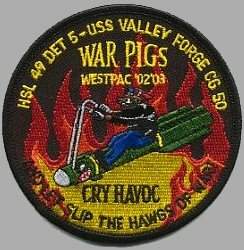 USS VALLEY FORGE finished WESTPAC 98 in December. The deployment was an overwhelming success for the ship and the ABRAHAM LINCOLN Battlegroup. VALLEY FORGE saw liberty in Japan, Hong Kong, Singapore, Albany and Melbourne Australia, and several Arabian Gulf ports. The ship's time on station in the Middle East was action packed with many new and interesting missions.
USS VALLEY FORGE finished WESTPAC 98 in December. The deployment was an overwhelming success for the ship and the ABRAHAM LINCOLN Battlegroup. VALLEY FORGE saw liberty in Japan, Hong Kong, Singapore, Albany and Melbourne Australia, and several Arabian Gulf ports. The ship's time on station in the Middle East was action packed with many new and interesting missions.
In April of 2000, VALLEY FORGE conducted a six-month Counter Drug Operation in the Southern Pacific as a part of the Joint-Interagency Task Force interdicting the illegal flow of narcotics into the United States and other countries being transported via the sea-lanes. Working in conjuntion with the Coast Guard, VALLEY FORGE seized approximately two and a half tons of cocaine. VALLEY FORGE returned in September after port visits to Acapulco, Panama, Ecuador, Puerto Vallarta, Cartegena, Mayport, Aruba, and Curacao.
USS VALLEY FORGE completed in mid-2001 its installation of a new integrated control system which utilizes the Navy's advanced smart ship technology, and is designed to provide an improved command and control system throughout the entire ship and in nearly every mission area.
Homeported in San Diego, California, VALLEY FORGE was a member of Destroyer Squadron TWENTY-ONE.
USS VALLEY FORGE in the News:
Some Details:
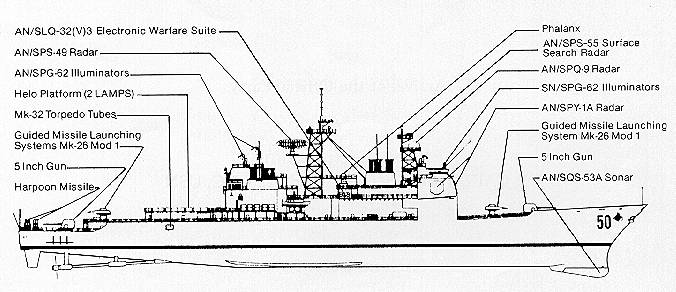
About the Cruiser's Name:
In the Chester County, Pennsylvania, area know as Valley Forge rests the foundation of freedom. It was there that General George Washington led a force of 12,000 men to winter encampment.
On December 19, 1777 when the force entered the encampment they were poorly equipped and lacked discipline and military training. In the six months in Valley Forge they faced starvation and illness that claimed an estimated 3,000 men. But through the snow and mud they began to form an Army. Under the watchful eye of George Washington and the Prussian General Friedrich von Steuben they began to train. They learned military tactics and discipline and they formed a chain of command.
On June 12, 1778 the Continental Army marched out of Valley Forge to engage the British army with a new born American spirit that led to victory.
USS VALLEY FORGE Image Gallery:
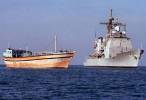 | 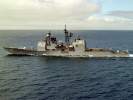 | 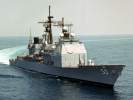 | 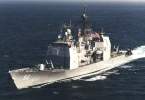 | 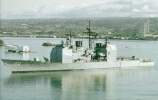 |
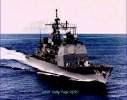 | 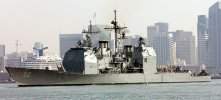 | 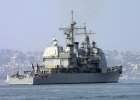 | 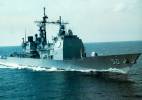 | |
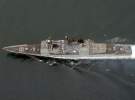 | 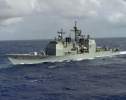 | 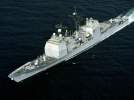 | 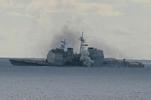 | |
The photo below was taken by William Chiu and shows USS VALLEY FORGE at Hong Kong on May 12, 1991.
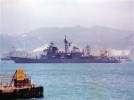 |
The photo below was taken by Karl-Heinz Ahles and shows USS VALLEY FORGE at Naval Base San Diego, Calif., in October 1997.
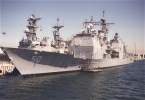 |
The photo below was taken by Michael Nebel and shows USS VALLEY FORGE berthed alongside an unidentified SPRUANCE - class destroyer at Naval Base San Diego, Calif., in 1998.
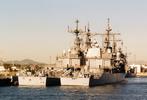 |
The photo below was taken by me on July 29, 2006, and shows the VALLEY FORGE [left], FLETCHER (DD 992) [center], and the CUSHING (DD 985) [right] laid-up at the Naval Inactive Ships Maintenance Facility in Pearl Harbor, HI. The VALLEY FORGE was sunk approx. 3 months later; FLETCHER and CUSHING were sunk approx. 2 years later.
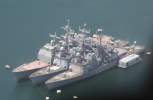 |
 Back to Cruisers list.
Back to Cruisers list.  Back to ships list.
Back to ships list.  Back to selection page.
Back to selection page.  Back to 1st page.
Back to 1st page.